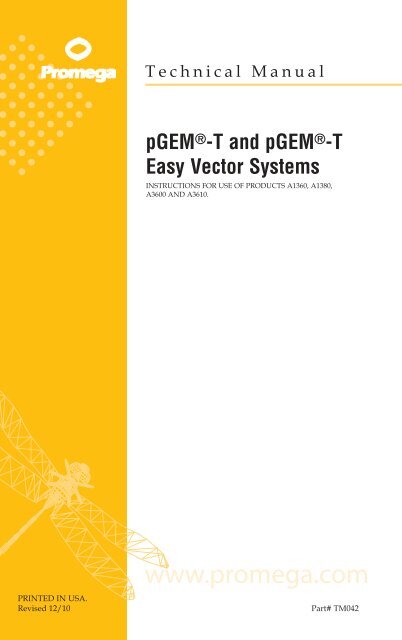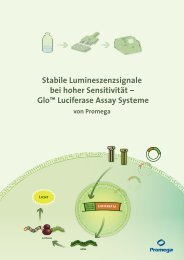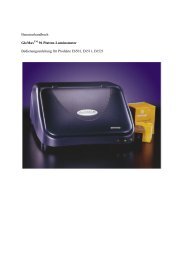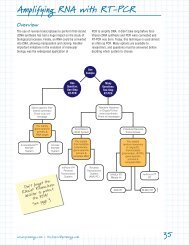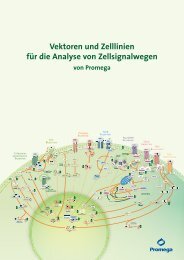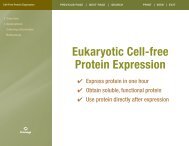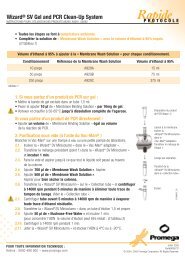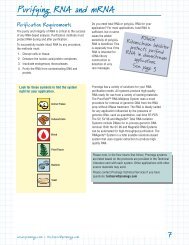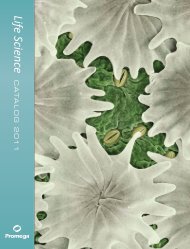pGEM-T and pGEM-T Easy Vector Systems Technical ... - Promega
pGEM-T and pGEM-T Easy Vector Systems Technical ... - Promega
pGEM-T and pGEM-T Easy Vector Systems Technical ... - Promega
Create successful ePaper yourself
Turn your PDF publications into a flip-book with our unique Google optimized e-Paper software.
<strong>Technical</strong> Manual<br />
<strong>pGEM</strong> ®-T <strong>and</strong> <strong>pGEM</strong> ®-T<br />
<strong>Easy</strong> <strong>Vector</strong> <strong>Systems</strong><br />
INSTRUCTIONS FOR USE OF PRODUCTS A1360, A1380,<br />
A3600 AND A3610.<br />
PRINTED IN USA.<br />
Revised 12/10 Part# TM042
<strong>pGEM</strong> ® -T <strong>and</strong> <strong>pGEM</strong> ® -T <strong>Easy</strong><br />
<strong>Vector</strong> <strong>Systems</strong><br />
All technical literature is available on the Internet at www.promega.com/tbs/<br />
Please contact <strong>Promega</strong> <strong>Technical</strong> Services if you have questions on use of this system.<br />
E-mail techserv@promega.com.<br />
1. Introduction ........................................................................................................2<br />
A. <strong>Vector</strong> Features ....................................................................................................2<br />
B. Important Considerations for Successful T-<strong>Vector</strong> Cloning..........................2<br />
2. Product Components <strong>and</strong> Storage Conditions ............................................3<br />
3. Protocol for Ligations Using the <strong>pGEM</strong> ®-T <strong>and</strong><br />
<strong>pGEM</strong> ® -T <strong>Easy</strong> <strong>Vector</strong>s <strong>and</strong> the 2X Rapid Ligation Buffer.......................4<br />
A. Ligation Protocol .................................................................................................4<br />
B. Optimizing Insert:<strong>Vector</strong> Molar Ratio ..............................................................5<br />
4. Transformations Using the <strong>pGEM</strong> ®-T<br />
<strong>and</strong> <strong>pGEM</strong> ® -T <strong>Easy</strong> <strong>Vector</strong> Ligation Reactions ...........................................6<br />
A. Transformation Protocol ....................................................................................6<br />
B. Example of Transformation Efficiency Calculation ........................................7<br />
C. Screening Transformants for Inserts .................................................................8<br />
5. <strong>pGEM</strong> ® -T <strong>and</strong> <strong>pGEM</strong> ® -T <strong>Easy</strong> <strong>Vector</strong> Sequences,<br />
Multi-Cloning Sites <strong>and</strong> Circle Maps ...........................................................8<br />
A. Sequence <strong>and</strong> Multi-Cloning Site of the <strong>pGEM</strong> ®-T <strong>Vector</strong> ...........................8<br />
B. <strong>pGEM</strong> ®-T <strong>Vector</strong> Map <strong>and</strong> Sequence Reference Points .................................9<br />
C. Sequence <strong>and</strong> Multi-Cloning Site of the <strong>pGEM</strong> ® -T <strong>Easy</strong> <strong>Vector</strong> ...............10<br />
D. <strong>pGEM</strong> ® -T <strong>Easy</strong> <strong>Vector</strong> Map <strong>and</strong> Sequence Reference Points......................11<br />
6. General Considerations for PCR Cloning .................................................12<br />
A. PCR Product Purity............................................................................................12<br />
B. Properties of Various Thermostable Polymerases ........................................12<br />
C. Cloning Blunt-Ended PCR Products ...............................................................13<br />
7. Experimental Controls ....................................................................................15<br />
8. Troubleshooting...............................................................................................16<br />
9. References .........................................................................................................20<br />
10. Appendix ..........................................................................................................20<br />
A. <strong>pGEM</strong> ®-T <strong>Vector</strong> Restriction Enzyme Sites....................................................20<br />
B. <strong>pGEM</strong> ®-T <strong>Easy</strong> <strong>Vector</strong> Restriction Enzyme Sites ..........................................22<br />
C. Composition of Buffers <strong>and</strong> Solutions ............................................................24<br />
D. Related Products.................................................................................................25<br />
<strong>Promega</strong> Corporation · 2800 Woods Hollow Road · Madison, WI 53711-5399 USA<br />
Toll Free in USA 800-356-9526 · Phone 608-274-4330 · Fax 608-277-2516 · www.promega.com<br />
Printed in USA. Part# TM042<br />
Revised 12/10 Page 1
1. Introduction<br />
1.A. <strong>Vector</strong> Features<br />
T-Overhangs for <strong>Easy</strong> PCR Cloning: The <strong>pGEM</strong> ®-T <strong>and</strong> <strong>pGEM</strong> ®-T <strong>Easy</strong><br />
<strong>Vector</strong>s (a,b) are linearized vectors with a single 3´-terminal thymidine at both<br />
ends. The T-overhangs at the insertion site greatly improve the efficiency of<br />
ligation of PCR products by preventing recircularization of the vector <strong>and</strong><br />
providing a compatible overhang for PCR products generated by certain<br />
thermostable polymerases (1,2).<br />
Blue/White Selection of Recombinants: The <strong>pGEM</strong> ® -T <strong>and</strong> <strong>pGEM</strong> ® -T <strong>Easy</strong><br />
<strong>Vector</strong>s are high-copy-number vectors containing T7 <strong>and</strong> SP6 RNA polymerase<br />
promoters flanking a multiple cloning region within the α-peptide coding region<br />
of the enzyme β-galactosidase. Insertional inactivation of the α-peptide allows<br />
identification of recombinants by blue/white screening on indicator plates.<br />
Choice of Restriction Sites for Release of Insert: Both the <strong>pGEM</strong> ® -T <strong>and</strong><br />
<strong>pGEM</strong> ® -T <strong>Easy</strong> <strong>Vector</strong>s contain numerous restriction sites within the multiple<br />
cloning region. The <strong>pGEM</strong> ®-T <strong>Easy</strong> <strong>Vector</strong> multiple cloning region is flanked by<br />
recognition sites for the restriction enzymes EcoRI, BstZI <strong>and</strong> NotI, providing<br />
three single-enzyme digestions for release of the insert. The <strong>pGEM</strong> ® -T <strong>Vector</strong><br />
cloning region is flanked by recognition sites for the enzyme BstZI. Alternatively,<br />
a double-digestion may be used to release the insert from either vector.<br />
Rapid Ligation: The <strong>pGEM</strong> ® -T <strong>and</strong> <strong>pGEM</strong> ® -T <strong>Easy</strong> <strong>Vector</strong> <strong>Systems</strong> are supplied<br />
with 2X Rapid Ligation Buffer. Ligation reactions using this buffer may be<br />
incubated for 1 hour at room temperature. The incubation period may be<br />
extended to increase the number of colonies after transformation. Generally, an<br />
overnight incubation at 4°C produces the maximum number of transformants.<br />
1.B. Important Considerations for Successful T-<strong>Vector</strong> Cloning<br />
• Avoid introduction of nucleases, which may degrade the T-overhangs on<br />
the vector. Use only the T4 DNA Ligase provided with the system, as this has<br />
been tested for minimal exonuclease activity. Use sterile, nuclease-free water<br />
in your ligation reactions.<br />
• Use high-efficiency competent cells (≥1 × 108cfu/µg DNA) for<br />
transformations. The ligation of fragments with a single-base overhang can<br />
be inefficient, so it is essential to use cells with a transformation efficiency of<br />
at least 1 × 108cfu/µg DNA in order to obtain a reasonable number of<br />
colonies. However, use of super high-efficiency competent cells (e.g., XL10<br />
Gold ® Cells) may result in a higher background of blue colonies.<br />
• Limit exposure of your PCR product to shortwave UV light to avoid<br />
formation of pyrimidine dimers. Use a glass plate between the gel <strong>and</strong> UV<br />
source. If possible, only visualize the PCR product with a long-wave UV<br />
source.<br />
<strong>Promega</strong> Corporation · 2800 Woods Hollow Road · Madison, WI 53711-5399 USA<br />
Toll Free in USA 800-356-9526 · Phone 608-274-4330 · Fax 608-277-2516 · www.promega.com<br />
Part# TM042 Printed in USA.<br />
Page 2 Revised 12/10
2. Product Components <strong>and</strong> Storage Conditions<br />
Product Size Cat.#<br />
<strong>pGEM</strong> ®-T <strong>Vector</strong> System I<br />
Includes:<br />
20 reactions A3600<br />
• 1.2µg <strong>pGEM</strong> ® -T <strong>Vector</strong> (50ng/µl)<br />
• 12µl Control Insert DNA (4ng/µl)<br />
• 100u T4 DNA Ligase<br />
• 200µl 2X Rapid Ligation Buffer, T4 DNA Ligase<br />
Product Size Cat.#<br />
<strong>pGEM</strong> ®-T <strong>Vector</strong> System II<br />
Includes:<br />
20 reactions A3610<br />
• 1.2µg <strong>pGEM</strong> ®-T <strong>Vector</strong> (50ng/µl)<br />
• 12µl Control Insert DNA (4ng/µl)<br />
• 100u T4 DNA Ligase<br />
• 200µl 2X Rapid Ligation Buffer, T4 DNA Ligase<br />
• 1.2ml JM109 Competent Cells, High Efficiency (6 × 200µl)<br />
Product Size Cat.#<br />
<strong>pGEM</strong> ®-T <strong>Easy</strong> <strong>Vector</strong> System I<br />
Includes:<br />
20 reactions A1360<br />
• 1.2µg <strong>pGEM</strong> ®-T <strong>Easy</strong> <strong>Vector</strong> (50ng/µl)<br />
• 12µl Control Insert DNA (4ng/µl)<br />
• 100u T4 DNA Ligase<br />
• 200µl 2X Rapid Ligation Buffer, T4 DNA Ligase<br />
Product Size Cat.#<br />
<strong>pGEM</strong> ® -T <strong>Easy</strong> <strong>Vector</strong> System II<br />
Includes:<br />
20 reactions A1380<br />
• 1.2µg <strong>pGEM</strong> ®-T <strong>Easy</strong> <strong>Vector</strong> (50ng/µl)<br />
• 12µl Control Insert DNA (4ng/µl)<br />
• 100u T4 DNA Ligase<br />
• 200µl 2X Rapid Ligation Buffer, T4 DNA Ligase<br />
• 1.2ml JM109 Competent Cells, High Efficiency (6 × 200µl)<br />
Storage Conditions: For Cat.# A3610, A1380, store the Competent Cells at<br />
–70°C. Store all other components at –20°C.<br />
<strong>Promega</strong> Corporation · 2800 Woods Hollow Road · Madison, WI 53711-5399 USA<br />
Toll Free in USA 800-356-9526 · Phone 608-274-4330 · Fax 608-277-2516 · www.promega.com<br />
Printed in USA. Part# TM042<br />
Revised 12/10 Page 3
3. Protocol for Ligations Using the <strong>pGEM</strong> ®-T <strong>and</strong> <strong>pGEM</strong> ®-T <strong>Easy</strong> <strong>Vector</strong>s <strong>and</strong> the<br />
2X Rapid Ligation Buffer<br />
3.A. Ligation Protocol<br />
1. Briefly centrifuge the <strong>pGEM</strong> ®-T or <strong>pGEM</strong> ®-T <strong>Easy</strong> <strong>Vector</strong> <strong>and</strong> Control Insert DNA<br />
tubes to collect the contents at the bottom of the tubes.<br />
2. Set up ligation reactions as described below.<br />
Note: Use 0.5ml tubes known to have low DNA-binding capacity (e.g., VWR<br />
Cat.# 20170-310).<br />
Vortex the 2X Rapid Ligation Buffer vigorously before each use.<br />
3. Mix the reactions by pipetting. Incubate the reactions for 1 hour at room<br />
temperature.<br />
Alternatively, if the maximum number of transformants is required, incubate the<br />
reactions overnight at 4°C.<br />
Reaction Component<br />
Notes:<br />
St<strong>and</strong>ard<br />
Reaction<br />
Positive<br />
Control<br />
1. Use only the T4 DNA Ligase supplied with this system to perform <strong>pGEM</strong> ®-T <strong>and</strong><br />
<strong>pGEM</strong> ®-T <strong>Easy</strong> <strong>Vector</strong> ligations. Other commercial preparations of T4 DNA ligase<br />
may contain exonuclease activities that may remove the terminal<br />
deoxythymidines from the vector.<br />
2. 2X Rapid Ligation Buffer contains ATP, which degrades during temperature<br />
fluctuations. Avoid multiple freeze-thaw cycles <strong>and</strong> exposure to frequent<br />
temperature changes by making single-use aliquots of the buffer.<br />
Background<br />
Control<br />
2X Rapid Ligation Buffer, T4 DNA Ligase 5µl 5µl 5µl<br />
<strong>pGEM</strong> ®-T or <strong>pGEM</strong> ®-T <strong>Easy</strong> <strong>Vector</strong> (50ng) 1µl 1µl 1µl<br />
PCR product Xµl* – –<br />
Control Insert DNA – 2µl –<br />
T4 DNA Ligase (3 Weiss units/µl) 1µl 1µl 1µl<br />
nuclease-free water to a final volume of 10µl 10µl 10µl<br />
*Molar ratio of PCR product:vector may require optimization.<br />
3. Longer incubation times will increase the number of transformants. Generally,<br />
incubation overnight at 4°C will produce the maximum number of transformants.<br />
<strong>Promega</strong> Corporation · 2800 Woods Hollow Road · Madison, WI 53711-5399 USA<br />
Toll Free in USA 800-356-9526 · Phone 608-274-4330 · Fax 608-277-2516 · www.promega.com<br />
Part# TM042 Printed in USA.<br />
Page 4 Revised 12/10
4. An aliquot of the PCR reaction should be analyzed on an agarose gel before<br />
use in the ligation reaction to verify that the reaction produced the desired<br />
product. The PCR product to be ligated can be gel-purified or purified<br />
directly from the PCR amplification using the Wizard ® SV Gel <strong>and</strong> PCR<br />
Clean-Up System (Cat.# A9281). Clean-up of reactions prior to ligation is<br />
recommended to remove primer dimers or other undesired reaction<br />
products, <strong>and</strong> to improve ligation efficiency. Exposure of PCR products to<br />
shortwave ultraviolet light should be minimized in order to avoid the<br />
formation of pyrimidine dimers.<br />
3.B. Optimizing Insert:<strong>Vector</strong> Molar Ratios<br />
The <strong>pGEM</strong> ®-T <strong>and</strong> <strong>pGEM</strong> ®-T <strong>Easy</strong> <strong>Vector</strong> <strong>Systems</strong> have been optimized using<br />
a 1:1 molar ratio of the Control Insert DNA to the vectors. However, ratios of<br />
8:1 to 1:8 have been used successfully. If initial experiments with your PCR<br />
product are suboptimal, ratio optimization may be necessary. Ratios from 3:1<br />
to 1:3 provide good initial parameters. The concentration of PCR product<br />
should be estimated by comparison to DNA mass st<strong>and</strong>ards on a gel or by<br />
using a fluorescent assay (3). The <strong>pGEM</strong> ®-T <strong>and</strong> <strong>pGEM</strong> ®-T <strong>Easy</strong> <strong>Vector</strong>s are<br />
approximately 3kb <strong>and</strong> are supplied at 50ng/µl. To calculate the appropriate<br />
amount of PCR product (insert) to include in the ligation reaction, use the<br />
following equation.<br />
ng of vector × kb size of insert × insert:vector molar ratio = ng of insert<br />
kb size of vector<br />
Example of insert:vector ratio calculation:<br />
How much 0.5kb PCR product should be added to a ligation in which 50ng of<br />
3.0kb vector will be used if a 3:1 insert:vector molar ratio is desired?<br />
50ng vector × 0.5kb insert 3<br />
× = 25ng insert<br />
3.0kb vector 1<br />
Using the same parameters for a 1:1 insert:vector molar ratio, 8.3ng of a 0.5kb<br />
insert would be required.<br />
Tip: The Biomath calculator (www.promega.com/biomath) can be<br />
used to determine the amount of insert DNA needed. The <strong>pGEM</strong> ® -T<br />
<strong>Vector</strong> size is 3000bp <strong>and</strong> the <strong>pGEM</strong> ®-T <strong>Easy</strong> <strong>Vector</strong> size is 3015bp.<br />
<strong>Promega</strong> Corporation · 2800 Woods Hollow Road · Madison, WI 53711-5399 USA<br />
Toll Free in USA 800-356-9526 · Phone 608-274-4330 · Fax 608-277-2516 · www.promega.com<br />
Printed in USA. Part# TM042<br />
Revised 12/10 Page 5
4. Transformations Using the <strong>pGEM</strong> ® -T <strong>and</strong> <strong>pGEM</strong> ® -T <strong>Easy</strong> <strong>Vector</strong><br />
Ligation Reactions<br />
Use high-efficiency competent cells (≥1 × 108cfu/µg DNA) for transformations.<br />
Ligation of fragments with a single-base overhang can be inefficient, so it is<br />
essential to use cells with a transformation efficiency of 1 × 108cfu/µg DNA (or<br />
higher) in order to obtain a reasonable number of colonies. We recommend<br />
using JM109 High Efficiency Competent Cells (Cat.# L2001); these cells are<br />
provided with the <strong>pGEM</strong> ®-T <strong>and</strong> <strong>pGEM</strong> ®-T <strong>Easy</strong> <strong>Vector</strong> <strong>Systems</strong> II. Other host<br />
strains may be used, but they should be compatible with blue/white color<br />
screening <strong>and</strong> st<strong>and</strong>ard ampicillin selection.<br />
Note: Use of super high-efficiency competent cells (e.g., XL10 Gold ®<br />
Ultracompetent Cells) may result in a higher background of blue colonies.<br />
If you are using competent cells other than JM109 High Efficiency Competent<br />
Cells purchased from <strong>Promega</strong>, it is important that the appropriate<br />
transformation protocol be followed. Selection for transformants should be on<br />
LB/ampicillin/IPTG/X-Gal plates (See recipe in Section10.C). For best results,<br />
do not use plates that are more than 1 month old.<br />
The genotype of JM109 is recA1, endA1, gyrA96, thi, hsdR17 (rK–,mK+),<br />
relA1, supE44, Δ(lac-proAB), [F´, traD36, proAB, lacI qZΔM15] (4).<br />
4.A. Transformation Protocol<br />
Materials to Be Supplied by the User<br />
(Solution Compositions are provided in Section 10.C)<br />
• LB plates with ampicillin/IPTG/X-Gal<br />
• SOC medium<br />
1. Prepare two LB/ampicillin/IPTG/X-Gal plates for each ligation reaction,<br />
plus two plates for determining transformation efficiency. Equilibrate the<br />
plates to room temperature.<br />
2. Centrifuge the tubes containing the ligation reactions to collect the contents<br />
at the bottom. Add 2µl of each ligation reaction to a sterile (17 × 100mm)<br />
polypropylene tube or a 1.5ml microcentrifuge tube on ice (see Note 1). Set<br />
up another tube on ice with 0.1ng uncut plasmid for determination of the<br />
transformation efficiency of the competent cells.<br />
3. Remove tube(s) of frozen JM109 High Efficiency Competent Cells from<br />
storage <strong>and</strong> place in an ice bath until just thawed (about 5 minutes). Mix the<br />
cells by gently flicking the tube. Avoid excessive pipetting, as the competent<br />
cells are extremely fragile.<br />
4. Carefully transfer 50µl of cells into each tube prepared in Step 2 (use 100µl of<br />
cells for determination of transformation efficiency).<br />
5. Gently flick the tubes to mix <strong>and</strong> place them on ice for 20 minutes.<br />
6. Heat-shock the cells for 45–50 seconds in a water bath at exactly 42°C (do not<br />
shake).<br />
<strong>Promega</strong> Corporation · 2800 Woods Hollow Road · Madison, WI 53711-5399 USA<br />
Toll Free in USA 800-356-9526 · Phone 608-274-4330 · Fax 608-277-2516 · www.promega.com<br />
Part# TM042 Printed in USA.<br />
Page 6 Revised 12/10
7. Immediately return the tubes to ice for 2 minutes.<br />
8. Add 950µl room-temperature SOC medium to the tubes containing cells<br />
transformed with ligation reactions <strong>and</strong> 900µl to the tube containing cells<br />
transformed with uncut plasmid (LB broth may be substituted, but colony<br />
number may be lower).<br />
9. Incubate for 1.5 hours at 37°C with shaking (~150rpm).<br />
10. Plate 100µl of each transformation culture onto duplicate LB/ampicillin/IPTG/<br />
X-Gal plates. For the transformation control, a 1:10 dilution with SOC medium<br />
is recommended for plating. If a higher number of colonies is desired, the cells<br />
may be pelleted by centrifugation at 1,000 × g for 10 minutes, resuspended in<br />
200µl of SOC medium, <strong>and</strong> 100µl plated on each of two plates.<br />
11. Incubate the plates overnight (16–24 hours) at 37°C. If 100µl is plated,<br />
approximately 100 colonies per plate are routinely seen using competent cells<br />
that are 1 × 10 8cfu/µg DNA. Use of ultra-high- efficiency competent cells may<br />
result in a higher number of background colonies. Longer incubations or<br />
storage of plates at 4°C (after 37°C overnight incubation) may be used to<br />
facilitate blue color development. White colonies generally contain inserts;<br />
however, inserts may also be present in blue colonies.<br />
Notes:<br />
1. We have found that use of larger (17 × 100mm) polypropylene tubes (e.g.,<br />
Falcon Cat.# 2059) increases transformation efficiency. Tubes from some<br />
manufacturers bind DNA <strong>and</strong> should be avoided.<br />
2. Colonies containing β-galactosidase activity may grow poorly relative to cells<br />
lacking this activity. After overnight growth, the blue colonies may be smaller<br />
than the white colonies, which are approximately one millimeter in diameter.<br />
3. Blue color will become darker after the plate has been stored overnight at 4ºC.<br />
4.B. Example of Transformation Efficiency Calculation<br />
After 100µl of competent cells are transformed with 0.1ng of uncut plasmid DNA,<br />
the transformation reaction is added to 900µl of SOC medium (0.1ng DNA/ml).<br />
From that volume, a 1:10 dilution with SOC medium (0.01ng DNA/ml) is made<br />
<strong>and</strong> 100µl plated on two plates (0.001ng DNA/100µl). If 200 colonies are obtained<br />
(average of two plates), what is the transformation efficiency?<br />
200cfu<br />
= 2 × 105cfu/ng = 2 × 108cfu/µg DNA<br />
0.001ng<br />
<strong>Promega</strong> Corporation · 2800 Woods Hollow Road · Madison, WI 53711-5399 USA<br />
Toll Free in USA 800-356-9526 · Phone 608-274-4330 · Fax 608-277-2516 · www.promega.com<br />
Printed in USA. Part# TM042<br />
Revised 12/10 Page 7
4.C. Screening Transformants for Inserts<br />
Successful cloning of an insert into the <strong>pGEM</strong> ®-T or <strong>pGEM</strong> ®-T <strong>Easy</strong> <strong>Vector</strong><br />
interrupts the coding sequence of β-galactosidase; recombinant clones can be<br />
identified by color screening on indicator plates. However, the characteristics of<br />
the PCR products cloned into the vectors can significantly affect the ratio of<br />
blue:white colonies obtained. Usually clones containing PCR products produce<br />
white colonies, but blue colonies can result from PCR fragments that are cloned<br />
in-frame with the lacZ gene. Such fragments are usually a multiple of 3 base<br />
pairs long (including the 3´-A overhangs) <strong>and</strong> do not contain in-frame stop<br />
codons. There have been reports of DNA fragments up to 2kb that have been<br />
cloned in-frame <strong>and</strong> have produced blue colonies. Even if your PCR product is<br />
not a multiple of 3 bases long, the amplification process can introduce<br />
mutations (deletions or point mutations) that may result in blue colonies.<br />
The Control Insert DNA supplied with the <strong>pGEM</strong> ®-T <strong>and</strong> <strong>pGEM</strong> ®-T <strong>Easy</strong><br />
<strong>Systems</strong> is a 542bp fragment from <strong>pGEM</strong> ®-luc <strong>Vector</strong> DNA (Cat.# E1541). This<br />
sequence has been mutated to contain multiple stop codons in all six reading<br />
frames, which ensures a low background of blue colonies for the control<br />
reaction. Results obtained with the Control Insert DNA may not be<br />
representative of those achieved with your PCR product.<br />
5. <strong>pGEM</strong> ®-T <strong>and</strong> <strong>pGEM</strong> ®-T <strong>Easy</strong> <strong>Vector</strong> Sequences, Multi-Cloning Sites <strong>and</strong><br />
Circle Maps<br />
5.A. Sequence <strong>and</strong> Multi-Cloning Site of the <strong>pGEM</strong> ®-T <strong>Vector</strong><br />
The <strong>pGEM</strong> ®-T <strong>Vector</strong> is derived from the <strong>pGEM</strong> ®-5Zf(+) <strong>Vector</strong> (GenBank ®<br />
Accession No. X65308). The <strong>pGEM</strong> ®-T <strong>Vector</strong> was created by linearizing the<br />
<strong>pGEM</strong> ®-5Zf(+) <strong>Vector</strong> with EcoRV at base 51 <strong>and</strong> adding a T to both 3´-ends.<br />
The EcoRV site will not be recovered upon ligation of the vector <strong>and</strong> insert.<br />
T7 Transcription Start<br />
5′ . . . TGTAA TACGA CTCAC TATAG GGCGA ATTGG GCCCG ACGTC GCATG CTCCC GGCCG<br />
3′ . . . ACATT ATGCT GAGTG ATATC CCGCT TAACC CGGGC TGCAG CGTAC GAGGG CCGGC<br />
T7 Promoter<br />
ApaI AatII SphI BstZI<br />
CCATG GCCGC GGGATT3′ ATCAC TAGTG CGGCC GCCTG CAGGT CGACC ATATG<br />
GGTAC CGGCG CCCTA ( 3′TTAGTG ATCAC GCCGG CGGAC GTCCA GCTGG TATAC<br />
cloned insert)<br />
NcoI SacII<br />
SpeI NotI<br />
BstZI<br />
PstI SalI NdeI<br />
SP6 Transcription Start<br />
GGAGA GCTCC CAACG CGTTG GATGC ATAGC TTGAG TATTC TATAG TGTCA CCTAA AT . . . 3′<br />
CCTCT CGAGG GTTGC GCAAC CTACG TATCG AACTC ATAAG ATATC ACAGT GGATT TA . . . 5′<br />
SacI BstXI NsiI<br />
SP6 Promoter<br />
Figure 1. The promoter <strong>and</strong> multiple cloning sequence of the <strong>pGEM</strong> ® -T <strong>Vector</strong>.<br />
The top str<strong>and</strong> corresponds to the RNA synthesized by T7 RNA polymerase. The<br />
bottom str<strong>and</strong> corresponds to the RNA synthesized by SP6 RNA polymerase.<br />
<strong>Promega</strong> Corporation · 2800 Woods Hollow Road · Madison, WI 53711-5399 USA<br />
Toll Free in USA 800-356-9526 · Phone 608-274-4330 · Fax 608-277-2516 · www.promega.com<br />
Part# TM042 Printed in USA.<br />
Page 8 Revised 12/10<br />
0357MA06_2A
!<br />
5.B. <strong>pGEM</strong> ®-T <strong>Vector</strong> Map <strong>and</strong> Sequence Reference Points<br />
XmnI 1994<br />
ScaI<br />
1875<br />
Amp r<br />
<strong>pGEM</strong> ® -T<br />
<strong>Vector</strong><br />
(3000bp)<br />
<strong>pGEM</strong> ®-T <strong>Vector</strong> sequence reference points:<br />
ori<br />
NaeI<br />
2692<br />
f1 ori<br />
T7<br />
1 start<br />
ApaI 14<br />
AatII 20<br />
SphI 26<br />
BstZI 31<br />
lacZ<br />
T T<br />
NcoI<br />
SacII<br />
37<br />
46<br />
SpeI 55<br />
NotI 62<br />
BstZI 62<br />
PstI 73<br />
SalI 75<br />
NdeI 82<br />
SacI 94<br />
BstXI 103<br />
NsiI 112<br />
SP6<br />
126<br />
T7 RNA polymerase transcription initiation site 1<br />
multiple cloning region 10–113<br />
SP6 RNA polymerase promoter (–17 to +3) 124–143<br />
SP6 RNA polymerase transcription initiation site 126<br />
pUC/M13 Reverse Sequencing Primer binding site 161–177<br />
lacZ start codon 165<br />
lac operator 185–201<br />
β-lactamase coding region 1322–2182<br />
phage f1 region 2365–2820<br />
lac operon sequences 2821–2981, 151–380<br />
pUC/M13 Forward Sequencing Primer binding site 2941–2957<br />
T7 RNA polymerase promoter (–17 to +3) 2984–3<br />
Note: Inserts can be sequenced using the SP6 Promoter Primer (Cat.# Q5011), T7<br />
Promoter Primer (Cat.# Q5021), pUC/M13 Forward Primer (Cat.# Q5601), or<br />
pUC/M13 Reverse Primer (Cat.# Q5421).<br />
Note: A single digest with BstZI (Cat.# R6881) will release inserts cloned into the<br />
<strong>pGEM</strong> ® -T <strong>Vector</strong>. Double digests can also be used to release inserts.<br />
<strong>Promega</strong> Corporation · 2800 Woods Hollow Road · Madison, WI 53711-5399 USA<br />
Toll Free in USA 800-356-9526 · Phone 608-274-4330 · Fax 608-277-2516 · www.promega.com<br />
Printed in USA. Part# TM042<br />
Revised 12/10 Page 9<br />
➞<br />
➞<br />
0356VA04_3A
5.C. Sequence <strong>and</strong> Multi-Cloning Site of the <strong>pGEM</strong> ® -T <strong>Easy</strong> <strong>Vector</strong><br />
The sequence of the <strong>pGEM</strong> ®-T <strong>Easy</strong> <strong>Vector</strong> is available at:<br />
www.promega.com/vectors/<br />
The <strong>pGEM</strong> ® -T <strong>Easy</strong> <strong>Vector</strong> has been linearized at base 60 with EcoRV <strong>and</strong> a T<br />
added to both 3´-ends. The EcoRV site will not be recovered upon ligation of the<br />
vector <strong>and</strong> insert.<br />
T7 Transcription Start<br />
5′ . . . TGTAA TACGA CTCAC TATAG GGCGA ATTGG GCCCG ACGTC GCATG CTCCC GGCCG CCATG<br />
3′ . . . ACATT ATGCT GAGTG ATATC CCGCT TAACC CGGGC TGCAG CGTAC GAGGG CCGGC GGTAC<br />
T7 Promoter<br />
ApaI AatII SphI BstZI NcoI<br />
GCGGC CGCGG GAATT CGATT3′ ATCAC TAGTG AATTC GCGGC CGCCT GCAGG TCGAC<br />
CGCCG GCGCC CTTAA GCTA ( 3′TTAGTG ATCAC TTAAG CGCCG GCGGA CGTCC AGCTG<br />
cloned insert)<br />
NotI NotI<br />
SacII EcoRI SpeI EcoRI<br />
PstI SalI<br />
BstZI<br />
BstZI<br />
SP6 Transcription Start<br />
CATAT GGGA GAGCT CCCAA CGCGT TGGAT GCATA GCTTG AGTAT TCTAT AGTGT CACCT AAAT . . . 3′<br />
GTATA CCCT CTCGA GGGTT GCGCA ACCTA CGTAT CGAAC TCATA AGATA TCACA GTGGA TTTA . . . 5′<br />
NdeI<br />
SacI BstXI NsiI<br />
SP6 Promoter<br />
Figure 2. The promoter <strong>and</strong> multiple cloning sequence of the <strong>pGEM</strong> ®-T <strong>Easy</strong> <strong>Vector</strong>.<br />
The top str<strong>and</strong> shown corresponds to the RNA synthesized by T7 RNA polymerase. The<br />
bottom str<strong>and</strong> corresponds to the RNA synthesized by SP6 RNA polymerase.<br />
More PCR Cloning Resources are available in the Cloning Chapter<br />
of the Protocols <strong>and</strong> Applications Guide at:<br />
www.promega.com/paguide<br />
<strong>Promega</strong> Corporation · 2800 Woods Hollow Road · Madison, WI 53711-5399 USA<br />
Toll Free in USA 800-356-9526 · Phone 608-274-4330 · Fax 608-277-2516 · www.promega.com<br />
Part# TM042 Printed in USA.<br />
Page 10 Revised 12/10<br />
1517MA
!<br />
5.D. <strong>pGEM</strong> ® -T <strong>Easy</strong> <strong>Vector</strong> Map <strong>and</strong> Sequence Reference Points<br />
XmnI 2009<br />
ScaI 1890<br />
Amp r<br />
<strong>pGEM</strong> ® -T <strong>Easy</strong><br />
<strong>Vector</strong><br />
(3015bp)<br />
<strong>pGEM</strong> ®-T <strong>Easy</strong> <strong>Vector</strong> sequence reference points:<br />
T7 RNA polymerase transcription initiation site 1<br />
multiple cloning region 10–128<br />
SP6 RNA polymerase promoter (–17 to +3) 139–158<br />
SP6 RNA polymerase transcription initiation site 141<br />
pUC/M13 Reverse Sequencing Primer binding site 176–197<br />
lacZ start codon 180<br />
lac operator 200–216<br />
β-lactamase coding region 1337–2197<br />
phage f1 region 2380–2835<br />
lac operon sequences 2836–2996, 166–395<br />
pUC/M13 Forward Sequencing Primer binding site 2949–2972<br />
T7 RNA polymerase promoter (–17 to +3) 2999–3<br />
ori<br />
T7<br />
ApaI<br />
AatII<br />
SphI<br />
BstZI<br />
NcoI<br />
BstZI<br />
NotI<br />
SacII<br />
EcoRI<br />
SpeI<br />
EcoRI<br />
NotI<br />
BstZI<br />
PstI<br />
SalI<br />
NdeI<br />
SacI<br />
BstXI<br />
NsiI<br />
Note: Inserts can be sequenced using the SP6 Promoter Primer (Cat.# Q5011), T7<br />
Promoter Primer (Cat.# Q5021), pUC/M13 Forward Primer (Cat.# Q5601), or<br />
pUC/M13 Reverse Primer (Cat.# Q5421).<br />
Note: A single digest with BstZI (Cat.# R6881), EcoRI (Cat.# R6011) or NotI (Cat.#<br />
R6431) will release inserts cloned into the <strong>pGEM</strong> ®-T <strong>Easy</strong> <strong>Vector</strong>. Double digests can<br />
also be used to release inserts.<br />
f1 ori<br />
NaeI 2707<br />
<strong>Promega</strong> Corporation · 2800 Woods Hollow Road · Madison, WI 53711-5399 USA<br />
Toll Free in USA 800-356-9526 · Phone 608-274-4330 · Fax 608-277-2516 · www.promega.com<br />
Printed in USA. Part# TM042<br />
Revised 12/10 Page 11<br />
lacZ<br />
T T<br />
➞<br />
➞<br />
SP6<br />
1 start<br />
14<br />
20<br />
26<br />
31<br />
37<br />
43<br />
43<br />
49<br />
52<br />
64<br />
70<br />
77<br />
77<br />
88<br />
90<br />
97<br />
109<br />
118<br />
127<br />
141<br />
1473VA05_6A
6 General Considerations for PCR Cloning<br />
6.A. PCR Product Purity<br />
An aliquot of the PCR reaction should be analyzed on an agarose gel before use<br />
in the ligation reaction. The PCR product can be gel-purified or purified directly<br />
from the PCR amplification using the Wizard ® SV Gel <strong>and</strong> PCR Clean-Up<br />
System (Cat.# A9281). Exposure to shortwave ultraviolet light should be<br />
minimized to avoid the formation of pyrimidine dimers. Even if distinct b<strong>and</strong>s<br />
of the expected size are observed, primer-dimers should be removed by gel<br />
purification or by using the Wizard ® SV Gel <strong>and</strong> PCR Clean-Up System. Use of<br />
crude PCR product may produce successful ligation in some cases; however, the<br />
number of white colonies containing the relevant insert may be reduced due to<br />
preferential incorporation of primer-dimers or other extraneous reaction<br />
products. Therefore, it may be necessary to screen numerous colonies in order to<br />
identify clones that contain the PCR product of interest.<br />
6.B. Properties of Various Thermostable Polymerases<br />
Not all thermostable polymerases generate fragments with 3´A-tailed fragments.<br />
Table 1 lists the properties of several commonly used polymerase enzymes.<br />
Table 1. Comparison of PCR Product Properties for Thermostable DNA Polymerases.<br />
Characteristic<br />
GoTaq ® /<br />
Taq/<br />
AmpliTaq ®<br />
Thermostable DNA Polymerase<br />
Tfl Tth Vent®<br />
(Tli)<br />
Deep<br />
Vent ® Pfu Pwo<br />
Resulting DNA ends 3´A 3´A 3´A Blunt Blunt Blunt Blunt<br />
5´→3´ exonuclease activity Yes Yes Yes No No No No<br />
3´→5´ exonuclease activity No No No Yes Yes Yes Yes<br />
<strong>Promega</strong> Corporation · 2800 Woods Hollow Road · Madison, WI 53711-5399 USA<br />
Toll Free in USA 800-356-9526 · Phone 608-274-4330 · Fax 608-277-2516 · www.promega.com<br />
Part# TM042 Printed in USA.<br />
Page 12 Revised 12/10
6.C. Cloning Blunt-Ended PCR Products<br />
Thermostable DNA polymerases with proofreading activity, such as Pfu DNA<br />
Polymerase (Cat.# M7741), Pwo DNA polymerase <strong>and</strong> Tli DNA Polymerase,<br />
generate blunt-ended fragments. Nevertheless, PCR products generated using<br />
these polymerases can be modified using the A-tailing procedure outlined in<br />
Figure 3 <strong>and</strong> ligated into the <strong>pGEM</strong> ®-T <strong>and</strong> <strong>pGEM</strong> ®-T <strong>Easy</strong> <strong>Vector</strong>s (5). Using<br />
this method, only one insert will be ligated into the vector (as opposed to<br />
multiple insertions that can occur with blunt-ended cloning). In addition, with<br />
T-vector cloning there is no need to dephosphorylate the vector, <strong>and</strong> there is a<br />
low background of religated vector.<br />
Using this procedure with optimized insert:vector ratios, 55–95% recombinants<br />
were obtained when Pfu <strong>and</strong> Tli DNA Polymerases were used to generate the<br />
insert DNA (Table 2). It is critical that the PCR fragments are purified using<br />
the Wizard ® SV Gel <strong>and</strong> PCR Clean-Up System (Cat.# A9281) or by direct<br />
isolation from a gel by other means. In the absence of purification, the<br />
proofreading activity of the Pfu, Pwo <strong>and</strong> Tli DNA Polymerases will degrade<br />
the PCR fragments, or remove the 3´-terminal deoxyadenosine added during<br />
tailing or the 3´-terminal deoxythymidine from the vector during the A-tailing<br />
reaction or ligation.<br />
To optimize cloning efficiency, the amount of DNA in the A-tailing reaction<br />
<strong>and</strong> the ligation volumes must be adjusted depending on the molar yield of<br />
the purified PCR product. When molar concentrations are high due to small<br />
fragment size <strong>and</strong>/or good amplification, small volumes of the PCR fragment<br />
are needed for the A-tailing <strong>and</strong> ligation reactions. However, when molar<br />
concentration is low due to large fragment size <strong>and</strong>/or poor amplification,<br />
large volumes of the PCR fragment are needed for the A-tailing <strong>and</strong> ligation<br />
reactions. We have successfully used 1–7µl of purified PCR fragment in Atailing<br />
reactions to optimize the insert:vector ratio. (See Section 3.B for further<br />
discussion of optimizing the insert:vector ratio.) Recombinants were identified<br />
by blue/white screening, <strong>and</strong> 70–100% were shown to have the correct size<br />
insert by PCR. Few recombinants were observed in control reactions in which<br />
the PCR fragment was not tailed. These control results confirm that the<br />
majority of the <strong>pGEM</strong> ®-T <strong>Easy</strong> <strong>Vector</strong> used contained 3´-terminal<br />
deoxythymidine <strong>and</strong> that, during the A-tailing, Taq DNA Polymerase added a<br />
3´-terminal deoxyadenosine to a significant proportion of the PCR fragments.<br />
<strong>Promega</strong> Corporation · 2800 Woods Hollow Road · Madison, WI 53711-5399 USA<br />
Toll Free in USA 800-356-9526 · Phone 608-274-4330 · Fax 608-277-2516 · www.promega.com<br />
Printed in USA. Part# TM042<br />
Revised 12/10 Page 13
Table 2. Comparison of A-Tailing Procedures.<br />
Polymerase<br />
1-Hour Ligation at 24°C<br />
(St<strong>and</strong>ard)<br />
% Recombinants 1<br />
16-Hour Ligation at 4°C<br />
(Alternative)<br />
542bp 1.8kb 542bp 1.8kb<br />
Pfu DNA Polymerase 65–84% 2 31–55% 3 81–95% 2 50–75% 3<br />
Tli DNA Polymerase 68–77% 4 37–65% 5 85–93% 4 60–81% 5<br />
PCR fragments generated by Pfu <strong>and</strong> Tli DNA Polymerase were A-tailed <strong>and</strong> ligated into<br />
<strong>pGEM</strong> ® -T <strong>Easy</strong> <strong>Vector</strong> for 1 hour at 24°C or for 16 hours at 4°C. Two microliters of ligation mix<br />
was transformed into JM109 Competent Cells <strong>and</strong> plated on LB/amp/IPTG/X-gal plates.<br />
1% Recombinants = % white <strong>and</strong>/or pale blue colonies. PCR fragments were purified with the<br />
Wizard ® PCR Preps DNA Purification System prior to A-tailing.<br />
2Insert:vector ratios tested: 5:1, 3:1, 1:1. Volume of PCR amplification product used in A-tailing:<br />
1–2µl.<br />
3Insert:vector ratios tested: 3:1, 2:1, 1:1. Volume of PCR amplification product used in A-tailing:<br />
3–7µl.<br />
4Insert:vector ratios tested: 3:1, 2:1, 1:1. Volume of PCR amplification product used in A-tailing:<br />
1–2µl.<br />
5Insert:vector ratios tested: 2:1, 1:1. Volume of PCR amplification product used in A-tailing:<br />
4–7µl.<br />
Start with 1–7µl of purified PCR fragment generated by a<br />
proofreading polymerase (e.g., Pfu DNA Polymerase).<br />
Add 1µl Taq DNA Polymerase 10X Reaction Buffer with MgCl 2.<br />
Add dATP to a final concentration of 0.2mM.<br />
Add 5 units of Taq DNA Polymerase.<br />
Add deionized water to a final reaction volume of 10µl.<br />
Incubate at 70°C for 15–30 minutes.<br />
Use 1–2µl in a ligation reaction with<br />
<strong>Promega</strong>’s <strong>pGEM</strong> ® -T <strong>and</strong> <strong>pGEM</strong> ® -T <strong>Easy</strong> <strong>Vector</strong>. 2357MA02_9A<br />
Figure 3. An A-tailing procedure for blunt-ended PCR fragments purified with the<br />
Wizard ® SV Gel <strong>and</strong> PCR Clean-Up System (Cat.# A9281) <strong>and</strong> used in T-vector<br />
cloning.<br />
<strong>Promega</strong> Corporation · 2800 Woods Hollow Road · Madison, WI 53711-5399 USA<br />
Toll Free in USA 800-356-9526 · Phone 608-274-4330 · Fax 608-277-2516 · www.promega.com<br />
Part# TM042 Printed in USA.<br />
Page 14 Revised 11/05
7. Experimental Controls<br />
Positive Control: Set up a ligation reaction with the Control Insert DNA as<br />
described in Section 3 <strong>and</strong> use it for transformations. This control will allow you<br />
to determine whether the ligation is proceeding efficiently. Typically,<br />
approximately 100 colonies should be observed, 10–40% of which are blue,<br />
when competent cells that have a transformation efficiency of 1 × 108cfu/µg DNA are transformed. Greater than 60% of the colonies should be white. The<br />
Control Insert DNA is designed to produce white colonies; however, other insert<br />
DNA may not yield white colonies (see Section 4.C). Background blue colonies<br />
from the positive control ligation reaction arise from non-T-tailed or undigested<br />
<strong>pGEM</strong> ®-T or <strong>pGEM</strong> ®-T <strong>Easy</strong> <strong>Vector</strong>. These blue colonies are a useful internal<br />
transformation control; if no colonies are obtained, the transformation has failed.<br />
If small numbers of blue colonies are obtained, but no whites, the ligation<br />
reaction may have failed. If
8. Troubleshooting<br />
For questions not addressed here, please contact your local <strong>Promega</strong> Branch Office or Distributor.<br />
Contact information available at: www.promega.com. E-mail: techserv@promega.com<br />
Symptoms Causes <strong>and</strong> Comments<br />
No colonies A problem has occurred with the transformation<br />
reaction or the cells have lost competence.<br />
Background undigested vector <strong>and</strong> religated non-Ttailed<br />
vector should yield 10–30 blue colonies<br />
independent of the presence of insert DNA. Check<br />
the background control (Section 7).<br />
Less than 10% white colonies<br />
with Control Insert DNA<br />
Use high-efficiency competent cells (≥1 × 10 8 cfu/µg<br />
DNA). Test the efficiency by transforming the cells<br />
with an uncut plasmid that allows for antibiotic<br />
selection, such as the <strong>pGEM</strong> ®-5Zf(+) <strong>Vector</strong>. If the<br />
guidelines in Section 4 are followed, cells at 1 ×<br />
10 8 cfu/µg DNA typically yield 100 colonies.<br />
Therefore, you would not see any colonies from cells<br />
that are
8. Troubleshooting (continued)<br />
Symptoms Causes <strong>and</strong> Comments<br />
Less than 10% white colonies with<br />
Control Insert DNA (continued)<br />
Less than 60% white colonies with<br />
Control Insert DNA<br />
Low number or no white colonies<br />
containing PCR product<br />
Ligation reaction has failed. Ligase buffer may DNA have<br />
low activity. The 2X Rapid Ligation Buffer contains ATP,<br />
which degrades during temperature fluctuations. Avoid<br />
multiple freeze-thaw cycles by making single-use aliquots<br />
of the buffer. Use a fresh vial of buffer. To test the activity<br />
of the ligase <strong>and</strong> buffer, set up a ligation with ~20ng of<br />
DNA markers (e.g., Lambda DNA/HindIII Markers, Cat.#<br />
G1711). Compare ligated <strong>and</strong> nonligated DNA on a gel <strong>and</strong><br />
check that the fragments have been religated into highmolecular-weight<br />
material.<br />
T-overhangs have been removed, allowing blunt-ended<br />
ligation of vector <strong>and</strong> giving rise to more blue than white<br />
colonies. Avoid introduction of nucleases, which may<br />
degrade the T-overhangs. Use only the T4 DNA Ligase<br />
provided with the system, which has been tested for<br />
minimal exonuclease activity. Also, use sterile, nucleasefree<br />
water.<br />
Improper dilution of the Rapid Ligation Buffer. The Rapid<br />
Ligation Buffer is provided at a 2X concentration. Use 5µl<br />
in a 10µl reaction.<br />
T-overhangs have been removed, allowing blunt-ended<br />
ligation of vector <strong>and</strong> giving rise to more blue than white<br />
colonies. Avoid introduction of nucleases, which may<br />
degrade the T-overhangs. Use only the T4 DNA Ligase<br />
provided with the system, which has been tested for<br />
minimal exonuclease activity.<br />
Ligation temperature is too high. Higher temperatures<br />
(>28°C) give rise to increased background <strong>and</strong> fewer<br />
recombinants.<br />
Improper dilution of the Rapid Ligation Buffer. The Rapid<br />
Ligation Buffer is provided at a 2X concentration. Use 5µl in<br />
a 10µl reaction.<br />
Ligation incubation is not long enough. Optimal results are<br />
seen with an overnight ligation.<br />
Failed ligation due to an inhibitory component in the PCR<br />
product. Mix some of the PCR product with the positive<br />
control ligation to determine whether an inhibitor is<br />
present. If an inhibitor is indicated, repurify the PCR<br />
fragment.<br />
<strong>Promega</strong> Corporation · 2800 Woods Hollow Road · Madison, WI 53711-5399 USA<br />
Toll Free in USA 800-356-9526 · Phone 608-274-4330 · Fax 608-277-2516 · www.promega.com<br />
Printed in USA. Part# TM042<br />
Revised 12/10 Page 17
8. Troubleshooting (continued)<br />
Symptoms Causes <strong>and</strong> Comments<br />
Low number or no white colonies<br />
containing PCR product (continued)<br />
PCR product is not ligating because there are no 3´-A<br />
overhangs. As summarized in Table 1, not all thermostable<br />
DNA polymerases create a 3´-A overhang (6,7). Bluntended<br />
fragments may be subsequently A-tailed by<br />
treatment with an appropriate polymerase <strong>and</strong> dATP<br />
(8–10).<br />
PCR product cannot be ligated due to pyrimidine dimers<br />
formed from UV over-exposure. This is a common problem<br />
with gel-purified DNA. There is no way to fix this; the<br />
DNA must be remade. Exposure to shortwave UV should<br />
be limited as much as possible. Use a glass plate between<br />
the gel <strong>and</strong> UV source to decrease UV overexposure. If<br />
possible, only visualize the PCR product using a longwave<br />
UV source<br />
The PCR fragment is inserted, but it is not disrupting the<br />
lacZ gene. If there are a higher number of blue colonies<br />
resulting from the PCR fragment ligation than with the<br />
background control, some of these blue colonies may<br />
contain insert. Screen blue <strong>and</strong> pale blue colonies (see<br />
Section 4.C)<br />
Insert:vector ratio is not optimal. Check the integrity <strong>and</strong><br />
quantity of your PCR fragment by gel analysis. Optimize<br />
the insert:vector ratio (see Section 3.B).<br />
There may be primer-dimers present in PCR fragment<br />
preparation. Primer-dimers will ligate into the <strong>pGEM</strong> ® -T or<br />
<strong>pGEM</strong> ® -T <strong>Easy</strong> <strong>Vector</strong> but may not be seen after restriction<br />
digestion <strong>and</strong> gel analysis because of their small size. The<br />
vector will appear to contain no insert. More blue colonies<br />
may be seen with the ligation than on the background<br />
control plates. The PCR fragment should be gel-purified.<br />
Multiple PCR products may have been generated <strong>and</strong><br />
cloned into the <strong>pGEM</strong> ®-T or <strong>pGEM</strong> ®-T <strong>Easy</strong> <strong>Vector</strong>.<br />
Gel-purify the PCR fragment of interest.<br />
<strong>Promega</strong> Corporation · 2800 Woods Hollow Road · Madison, WI 53711-5399 USA<br />
Toll Free in USA 800-356-9526 · Phone 608-274-4330 · Fax 608-277-2516 · www.promega.com<br />
Part# TM042 Printed in USA.<br />
Page 18 Revised 12/10
8. Troubleshooting (continued)<br />
Symptoms Causes <strong>and</strong> Comments<br />
Low number or no white colonies<br />
containing PCR product<br />
(continued)<br />
PCR product ligation reaction<br />
produces white colonies only<br />
(no blue colonies)<br />
Not enough clones contain the PCR<br />
product of interest<br />
DNA has rearranged. Check a number of clones to see<br />
whether the rearrangement is r<strong>and</strong>om. If so, the clone of<br />
interest should be present <strong>and</strong> can be identified by<br />
screening several clones. If the same rearrangement is found<br />
in all of the clones, use of a repair-deficient bacterial strain<br />
(e.g., SURE ® cells) may reduce recombination events.<br />
Ampicillin is inactive, allowing ampicillin- sensitive cells to<br />
grow. Check that ampicillin plates are made properly <strong>and</strong><br />
used within one month. Test ampicillin activity by streaking<br />
plates, with <strong>and</strong> without ampicillin, using an ampicillinsensitive<br />
clone.<br />
The bacterial strain (e.g., JM109) has lost its F´ episome, or<br />
the bacterial strain used is not compatible with blue/white<br />
screening. Check the background control. If these colonies<br />
are not blue, the cells may have lost the F´ episome<br />
(assuming lacI qZΔM15 is located on the F´ in the<br />
transformed strain <strong>and</strong> appropriate plates were used). Be<br />
sure that the cells are prepared properly for use with this<br />
system (see Section 4).<br />
Plates are incompatible with blue/white screening. Check<br />
the background control. If these colonies are not blue, check<br />
that the plates have ampicillin/IPTG/X-Gal <strong>and</strong> are fresh. If<br />
there is any question about the quality of the plates, repeat<br />
plating with fresh plates<br />
Insufficient A-tailing of the PCR fragment. After the PCR<br />
product of interest urification of the PCR fragment, set up<br />
an A-tailing reaction (8–10). Clean up the sample <strong>and</strong><br />
proceed with the protocol.<br />
Insert:vector ratio is not optimal. Check the integrity <strong>and</strong><br />
quality of your PCR fragment by gel analysis. Optimize the<br />
insert:vector ratio (see Section 3.B).<br />
Multiple PCR products are generated <strong>and</strong> cloned into the<br />
<strong>pGEM</strong> ® -T or <strong>pGEM</strong> ® -T <strong>Easy</strong> <strong>Vector</strong>. Gel-purify the PCR<br />
fragment of interest.<br />
<strong>Promega</strong> Corporation · 2800 Woods Hollow Road · Madison, WI 53711-5399 USA<br />
Toll Free in USA 800-356-9526 · Phone 608-274-4330 · Fax 608-277-2516 · www.promega.com<br />
Printed in USA. Part# TM042<br />
Revised 12/10 Page 19
9. References<br />
1. Mezei, L.M. <strong>and</strong> Storts, D.R. (1994) Purification of PCR products. In: PCR Technology:<br />
Current Innovations, Griffin, H.G. <strong>and</strong> Griffin, A.M., eds., CRC Press, Boca Raton, FL, 21.<br />
2. Robles, J. <strong>and</strong> Doers, M. (1994) <strong>pGEM</strong> ®-T <strong>Vector</strong> <strong>Systems</strong> troubleshooting guide.<br />
<strong>Promega</strong> Notes 45, 19–20.<br />
3. Haff, L. <strong>and</strong> Mezei, L. (1989) Amplifications 1, 8.<br />
4. Messing, J. et al. (1981) A system for shotgun DNA sequencing. Nucl. Acids Res. 9,<br />
309–21.<br />
5. Knoche, K. <strong>and</strong> Kephart, D. (1999) Cloning blunt-end Pfu DNA Polymerase-generated<br />
PCR fragments into <strong>pGEM</strong> ® -T <strong>Vector</strong> <strong>Systems</strong>. <strong>Promega</strong> Notes 71, 10–13.<br />
6. Clark, J.M. (1988) Novel non-templated nucleotide addition reactions catalyzed by<br />
procaryotic <strong>and</strong> eucaryotic DNA polymerases. Nucl. Acids Res. 16, 9677–86.<br />
7. Newton, C.R. <strong>and</strong> Graham, A. (1994) In: PCR, BIOS Scientific Publishers, Ltd.,<br />
Oxford, UK, 13.<br />
8 Kobs, G. (1995) <strong>pGEM</strong> ® -T <strong>Vector</strong>: Cloning of modified blunt-ended DNA fragments.<br />
<strong>Promega</strong> Notes 55, 28–29.<br />
9. Kobs, G. (1997) Cloning blunt-end DNA fragments into the <strong>pGEM</strong> ® -T <strong>Vector</strong><br />
<strong>Systems</strong>. <strong>Promega</strong> Notes 62, 15–18.<br />
10. Zhou, M.-Y., Clark, S.E. <strong>and</strong> Gomez-Sanchez, C.E. (1995) Universal cloning method<br />
by TA strategy. BioTechniques 19, 34–35.<br />
10. Appendix<br />
10.A. <strong>pGEM</strong> ®-T <strong>Vector</strong> Restriction Enzyme Sites<br />
The <strong>pGEM</strong> ®-T <strong>Vector</strong> is derived from the circular <strong>pGEM</strong> ®-5Zf(+) <strong>Vector</strong><br />
(GenBank ® Accession No. X65308). The <strong>pGEM</strong> ®-5Zf(+) <strong>Vector</strong> sequence is<br />
available at: www.promega.com/vectors/<br />
The following restriction enzyme tables are based on those of the circular<br />
<strong>pGEM</strong> ® -5Zf(+) <strong>Vector</strong>. The <strong>pGEM</strong> ® -T <strong>Vector</strong> has been created by linearizing the<br />
<strong>pGEM</strong> ®-5Zf(+) <strong>Vector</strong> with EcoRV at base 51 <strong>and</strong> adding a T to both 3´-ends.<br />
This site will not be recovered upon ligation of the vector <strong>and</strong> insert. The<br />
following tables were constructed using DNASTAR ® sequence analysis<br />
software. Please note that we have not verified this information by restriction<br />
digestion with each enzyme listed. The location given specifies the 3´-end of the<br />
cut DNA (the base to the left of the cut site). Please contact your local <strong>Promega</strong><br />
Branch Office or Distributor if you identify a discrepancy. In the U.S., contact<br />
<strong>Technical</strong> Services at 1-800-356-9526.<br />
<strong>Promega</strong> Corporation · 2800 Woods Hollow Road · Madison, WI 53711-5399 USA<br />
Toll Free in USA 800-356-9526 · Phone 608-274-4330 · Fax 608-277-2516 · www.promega.com<br />
Part# TM042 Printed in USA.<br />
Page 20 Revised 12/10
Table 3. Restriction Enzymes That Cut the <strong>pGEM</strong> ® -T <strong>Vector</strong> 1–5 Times.<br />
Enzyme # of Sites Location<br />
AatII 1 20<br />
AccI 1 76<br />
AcyI 2 17, 1932<br />
AflIII 2 99, 502<br />
Alw26I 2 1456, 2232<br />
Alw44I 2 816, 2062<br />
AlwNI 1 918<br />
ApaI 1 14<br />
AspHI 4 94, 820, 1981, 2066<br />
AvaII 2 1533, 1755<br />
BanI 3 246, 1343, 2626<br />
BanII 3 14, 94, 2664<br />
BbuI 1 26<br />
BglI 3 39, 1515, 2833<br />
BsaI 1 1456<br />
BsaAI 1 2589<br />
BsaHI 2 17, 1932<br />
BsaJI 5 37, 43, 241, 662,<br />
2936<br />
Bsp120I 1 10<br />
BspHI 2 1222, 2230<br />
BspMI 1 62<br />
BssSI 2 675, 2059<br />
BstOI 5 242, 530, 651,<br />
664, 2937<br />
BstXI 1 103<br />
BstZI 2 31, 62<br />
Cfr10I 2 1475, 2690<br />
DdeI 4 777, 1186, 1352,<br />
1892<br />
DraI 3 1261, 1280, 1972<br />
DraIII 1 2589<br />
DrdI 2 610, 2544<br />
DsaI 2 37, 43<br />
EagI 2 31, 62<br />
EarI 3 386, 2190, 2878<br />
EclHKI 1 1395<br />
Eco52I 2 31, 62<br />
EcoICRI 1 92<br />
EcoRV 1 51*<br />
Enzyme # of Sites Location<br />
FokI 5 119, 1361, 1542,<br />
1829, 2919<br />
FspI 2 1617, 2840<br />
HaeII 4 380, 750, 2740,<br />
2748<br />
HgaI 4 613, 1191, 1921,<br />
2806<br />
HincII 1 77<br />
HindII 1 77<br />
Hsp92I 2 17, 1932<br />
MaeI 5 56, 997, 1250,<br />
1585, 2740<br />
MluI 1 99<br />
NaeI 1 2692<br />
NciI 4 30, 882, 1578, 1929<br />
NcoI 1 37<br />
NdeI 1 82<br />
NgoMIV 1 2690<br />
NotI 1 62<br />
NsiI 1 112<br />
NspI 2 26, 506<br />
Ppu10I 1 108<br />
PstI 1 73<br />
PvuI 2 1765, 2861<br />
PvuII 2 326, 2890<br />
RsaI 1 1875<br />
SacI 1 94<br />
SacII 1 46<br />
SalI 1 75<br />
ScaI 1 1875<br />
SfiI 1 39<br />
SinI 2 1533, 1755<br />
SpeI 1 55<br />
SphI 1 26<br />
Sse8387I 1 73<br />
SspI 2 2199, 2381<br />
StyI 1 37<br />
TaqI 4 76, 602, 2046, 2622<br />
TfiI 2 337, 477<br />
VspI 3 273, 332, 1567<br />
XmnI 1 1994<br />
*The <strong>pGEM</strong> ® -T <strong>Vector</strong> has been created by linearizing the <strong>pGEM</strong> ® -5Zf(+) <strong>Vector</strong> with<br />
EcoRV at base 51 <strong>and</strong> adding a T to both 3´-ends. This site will not be recovered upon<br />
ligation of the vector <strong>and</strong> insert.<br />
Note: The enzymes listed in boldface type are available from <strong>Promega</strong>.<br />
<strong>Promega</strong> Corporation · 2800 Woods Hollow Road · Madison, WI 53711-5399 USA<br />
Toll Free in USA 800-356-9526 · Phone 608-274-4330 · Fax 608-277-2516 · www.promega.com<br />
Printed in USA. Part# TM042<br />
Revised 12/10 Page 21
Table 4. Restriction Enzymes That Do Not Cut the <strong>pGEM</strong> ®-T <strong>Vector</strong>.<br />
AccB7I<br />
AccIII<br />
Acc65I<br />
AflII<br />
AgeI<br />
AscI<br />
AvaI<br />
AvrII<br />
BalI<br />
BamHI<br />
BbeI<br />
BbrPI<br />
BbsI<br />
BclI<br />
BglII<br />
BlpI<br />
Bpu1102I<br />
BsaBI<br />
BsaMI<br />
BsmI<br />
BsrGI<br />
BssHII<br />
Bst1107I<br />
Bst98I<br />
BstEII<br />
Bsu36I<br />
ClaI<br />
CspI<br />
Csp45I<br />
DraII<br />
Eco47III<br />
Eco72I<br />
Eco81I<br />
EcoNI<br />
EcoRI<br />
EheI<br />
FseI<br />
HindIII<br />
HpaI<br />
I-PpoI<br />
KasI<br />
KpnI<br />
NarI<br />
NheI<br />
NruI<br />
PacI<br />
PaeR7I<br />
PflMI<br />
10.B. <strong>pGEM</strong> ® -T <strong>Easy</strong> <strong>Vector</strong> Restriction Enzyme Sites<br />
PinAI<br />
PmeI<br />
PmlI<br />
PpuMI<br />
PshAI<br />
Psp5II<br />
PspAI<br />
RsrII<br />
SgfI<br />
SgrAI<br />
SmaI<br />
SnaBI<br />
SplI<br />
SrfI<br />
StuI<br />
SwaI<br />
Tth111I<br />
XbaI<br />
XcmI<br />
XhoI<br />
XmaI<br />
The sequence of the <strong>pGEM</strong> ®-T <strong>Easy</strong> <strong>Vector</strong> is available on the Internet at:<br />
www.promega.com/vectors/<br />
The <strong>pGEM</strong> ® -T <strong>Easy</strong> <strong>Vector</strong> has been linearized at base 60 with EcoRV <strong>and</strong> a T<br />
added to both 3´-ends. This site will not be recovered upon ligation of the vector<br />
<strong>and</strong> insert. The following tables were constructed using DNASTAR ® sequence<br />
analysis software. Please note that we have not verified this information by<br />
restriction digestion with each enzyme listed. The location given specifies the 3´end<br />
of the cut DNA (the base to the left of the cut site). Please contact your local<br />
<strong>Promega</strong> Branch Office or Distributor if you identify a discrepancy. In the U.S.,<br />
contact <strong>Technical</strong> Services at 1-800-356-9526.<br />
<strong>Promega</strong> Corporation · 2800 Woods Hollow Road · Madison, WI 53711-5399 USA<br />
Toll Free in USA 800-356-9526 · Phone 608-274-4330 · Fax 608-277-2516 · www.promega.com<br />
Part# TM042 Printed in USA.<br />
Page 22 Revised 12/10
Table 5. Restriction Enzymes that Cut the <strong>pGEM</strong> ®-T <strong>Easy</strong> <strong>Vector</strong> 1–5 Times.<br />
Enzyme # of Sites Location<br />
AatII 1 20<br />
AccI 1 91<br />
AcyI 2 17, 1947<br />
AflIII 2 114, 517<br />
Alw26I 2 1471, 2247<br />
Alw44I 2 831, 2077<br />
AlwNI 1 933<br />
ApaI 1 14<br />
AspHI 4 109, 835, 1996,<br />
2081<br />
AvaII 2 1548, 1770<br />
BanI 3 261, 1358, 2641<br />
BanII 3 14, 109, 2679<br />
BbuI 1 26<br />
BglI 4 39, 42, 1530, 2848<br />
BsaI 1 1471<br />
BsaAI 1 2604<br />
BsaHI 2 17, 1947<br />
BsaJI 5 37, 46, 256, 677,<br />
2951<br />
Bsp120I 1 10<br />
BspHI 2 1237, 2245<br />
BspMI 1 77<br />
BssSI 2 690, 2074<br />
BstOI 5 257, 545, 666, 679,<br />
2952<br />
BstXI 1 118<br />
BstZI 3 31, 43, 77<br />
Cfr10I 2 1490, 2705<br />
DdeI 4 792, 1201, 1367,<br />
1907<br />
DraI 3 1276, 1295, 1987<br />
DraIII 1 2604<br />
DrdI 2 625, 2559<br />
DsaI 2 37, 46<br />
EagI 3 31, 43, 77<br />
EarI 3 401, 2205, 2893<br />
EclHKI 1 1410<br />
Eco52I 3 31, 43, 77<br />
EcoICRI 1 107<br />
EcoRI 2 52, 70<br />
EcoRV 1 60*<br />
Enzyme # of Sites Location<br />
FokI 5 134, 1376, 1557,<br />
1844, 2931<br />
FspI 2 1632, 2855<br />
HaeII 4 395, 765, 2755,<br />
2763<br />
HgaI 4 628, 1206, 1936,<br />
2821<br />
HincII 1 92<br />
HindII 1 92<br />
Hsp92I 2 17, 1947<br />
MaeI 5 65, 1012, 1265,<br />
1600, 2755<br />
MluI 1 114<br />
NaeI 1 2707<br />
NciI 4 30, 897, 1593,<br />
1944<br />
NcoI 1 37<br />
NdeI 1 97<br />
NgoMIV 1 2705<br />
NotI 2 43, 77<br />
NsiI 1 127<br />
NspI 2 26, 521<br />
Ppu10I 1 123<br />
PstI 1 88<br />
PvuI 2 1780, 2876<br />
PvuII 2 341, 2905<br />
RsaI 1 1890<br />
SacI 1 109<br />
SacII 1 49<br />
SalI 1 90<br />
ScaI 1 1890<br />
SinI 2 1548, 1770<br />
SpeI 1 64<br />
SphI 1 26<br />
Sse8387I 1 88<br />
SspI 2 2214, 2396<br />
StyI 1 37<br />
TaqI 5 56, 91, 617, 2061,<br />
2637<br />
TfiI 2 352, 492<br />
VspI 3 288, 347, 1582<br />
XmnI 1 2009<br />
*The <strong>pGEM</strong> ®-T <strong>Easy</strong> <strong>Vector</strong> has been linearized at base 60 with EcoRV <strong>and</strong> a T added to both<br />
3´-ends. This site will not be recovered upon ligation of the vector <strong>and</strong> insert.<br />
Note: The enzymes listed in boldface type are available from <strong>Promega</strong>.<br />
<strong>Promega</strong> Corporation · 2800 Woods Hollow Road · Madison, WI 53711-5399 USA<br />
Toll Free in USA 800-356-9526 · Phone 608-274-4330 · Fax 608-277-2516 · www.promega.com<br />
Printed in USA. Part# TM042<br />
Revised 12/10 Page 23
Table 6. Restriction Enzymes That Do Not Cut the <strong>pGEM</strong> ®-T <strong>Easy</strong> <strong>Vector</strong>.<br />
AccB7I<br />
AccIII<br />
Acc65I<br />
AflII<br />
AgeI<br />
AscI<br />
AvaI<br />
AvrII<br />
BalI<br />
BamHI<br />
BbeI<br />
BbrPI<br />
BbsI<br />
BclI<br />
BglII<br />
BlpI<br />
Bpu1102I<br />
BsaBI<br />
BsaMI<br />
BsmI<br />
BsrGI<br />
BssHII<br />
Bst1107I<br />
Bst98I<br />
10.C. Composition of Buffers <strong>and</strong> Solutions<br />
IPTG stock solution (0.1M)<br />
1.2g IPTG<br />
Add water to 50ml final volume. Filtersterilize<br />
<strong>and</strong> store at 4°C.<br />
X-Gal (2ml)<br />
100mg 5-bromo-4-chloro-3indolyl-β-D-galactoside<br />
Dissolve in 2ml N,N´-dimethylformamide.<br />
Cover with aluminum foil<br />
<strong>and</strong> store at –20°C.<br />
LB medium (per liter)<br />
10g Bacto ® -tryptone<br />
5g Bacto ® -yeast extract<br />
5g NaCl<br />
Adjust pH to 7.0 with NaOH.<br />
BstEII<br />
Bsu36I<br />
ClaI<br />
CspI<br />
Csp45I<br />
DraII<br />
Eco47III<br />
Eco72I<br />
Eco81I<br />
EcoNI<br />
EheI<br />
FseI<br />
HindIII<br />
HpaI<br />
I-PpoI<br />
KasI<br />
KpnI<br />
NarI<br />
NheI<br />
NruI<br />
PacI<br />
PaeR7I<br />
PflMI<br />
PinAI<br />
PmeI<br />
PmlI<br />
PpuMI<br />
PshAI<br />
Psp5II<br />
PspAI<br />
RsrII<br />
SfiI<br />
SgfI<br />
SgrAI<br />
SmaI<br />
SnaBI<br />
Note: The enzymes listed in boldface type are available from <strong>Promega</strong>.<br />
SplI<br />
SrfI<br />
StuI<br />
SwaI<br />
Tth111I<br />
XbaI<br />
XcmI<br />
XhoI<br />
XmaI<br />
LB plates with ampicillin<br />
Add 15g agar to 1 liter of LB medium.<br />
Autoclave. Allow the medium to cool to<br />
50°C before adding ampicillin to a final<br />
concentration of 100µg/ml. Pour<br />
30–35ml of medium into 85mm petri<br />
dishes. Let the agar harden. Store at 4°C<br />
for up to 1 month or at room<br />
temperature for up to 1 week.<br />
LB plates with ampicillin/IPTG/X-Gal<br />
Make the LB plates with ampicillin as<br />
above; then supplement with 0.5mM<br />
IPTG <strong>and</strong> 80µg/ml X-Gal <strong>and</strong> pour the<br />
plates. Alternatively, 100µl of 100mM<br />
IPTG <strong>and</strong> 20µl of 50mg/ml X-Gal may<br />
be spread over the surface of an LBampicillin<br />
plate <strong>and</strong> allowed to absorb<br />
for 30 minutes at 37°C prior to use.<br />
<strong>Promega</strong> Corporation · 2800 Woods Hollow Road · Madison, WI 53711-5399 USA<br />
Toll Free in USA 800-356-9526 · Phone 608-274-4330 · Fax 608-277-2516 · www.promega.com<br />
Part# TM042 Printed in USA.<br />
Page 24 Revised 12/10
SOC medium (100ml)<br />
2.0g Bacto ®-tryptone<br />
0.5g Bacto ®-yeast extract<br />
1ml 1M NaCl<br />
0.25ml 1M KCl<br />
1ml 2M Mg2+ stock, filtersterilized<br />
1ml 2M glucose, filter-sterilized<br />
Add Bacto ® -tryptone, Bacto ® -yeast<br />
extract, NaCl <strong>and</strong> KCl to 97ml distilled<br />
water. Stir to dissolve. Autoclave <strong>and</strong><br />
cool to room temperature. Add 2M<br />
Mg2+ stock <strong>and</strong> 2M glucose, each to a<br />
final concentration of 20mM. Bring to<br />
100ml with sterile, distilled water. The<br />
final pH should be 7.0.<br />
2M Mg2+ stock<br />
20.33g MgCl2 • 6H2O 24.65g MgSO4 • 7H2O Add distilled water to 100ml. Filter<br />
sterilize.<br />
10.D. Related Products<br />
PCR Cloning <strong>Systems</strong><br />
Product Size Cat.#<br />
pTARGET Mammalian Expression <strong>Vector</strong> System<br />
Direct mammalian expression from a T-<strong>Vector</strong>.<br />
20 reactions A1410<br />
Amplification Products<br />
2X Rapid Ligation Buffer, T4 DNA<br />
Ligase (provided)<br />
60mM Tris-HCl (pH 7.8)<br />
20mM MgCl2 20mM DTT<br />
2mM ATP<br />
10% polyethylene glycol<br />
(MW8000, ACS Grade)<br />
Store in single-use aliquots at –20°C.<br />
Avoid multiple freeze-thaw cycles.<br />
TYP broth (per liter)<br />
16g Bacto ® -tryptone<br />
16g Bacto ®-yeast extract<br />
5g NaCl<br />
2.5g K2HPO4 A partial list of our amplification products is given on the next page. Please visit our<br />
Web site at: www.promega.com/applications/pcr/ to see a complete list.<br />
<strong>Promega</strong> Corporation · 2800 Woods Hollow Road · Madison, WI 53711-5399 USA<br />
Toll Free in USA 800-356-9526 · Phone 608-274-4330 · Fax 608-277-2516 · www.promega.com<br />
Printed in USA. Part# TM042<br />
Revised 12/10 Page 25
10.D. Related Products (continued)<br />
Thermostable DNA Polymerases<br />
Product Size Cat.#<br />
GoTaq ® Hot Start Polymerase* 100u M5001<br />
GoTaq ® DNA Polymerase 100u M3171 1 , M3001 2<br />
GoTaq ® Flexi DNA Polymerase<br />
(allows optimization of Mg2+ concentration in reaction) 100u M8291 1 , M8301 2<br />
Additional sizes available. 1 Cat.#s M3171, & M8301 are available in Europe or through<br />
Distributors supported by <strong>Promega</strong> European Branch Offices. 2 Cat.#s M3001, & M8291 are<br />
available in all other countries, including the United States. *For Research Use Only. Not for<br />
use in diagnostic procedures.<br />
PCR Master Mixes<br />
Product Size Cat.#<br />
GoTaq ® Hot Start Green Master Mix* 100 reactions M5122<br />
1,000 reactions M5123<br />
GoTaq ® Hot Start Colorless Master Mix* 100 reactions M5132<br />
1,000 reactions M5133<br />
GoTaq ® Green Master Mix 100 reactions M71121 , M71222 1,000 reactions M71131, M71232 GoTaq ® Colorless Master Mix 100 reactions M71421, M71322 1,000 reactions M71431, M71332 GoTaq ® Master Mixes are premixed solutions containing GoTaq ® DNA Polymerase, GoTaq ®<br />
Reaction Buffer (Green or Colorless), dNTPs <strong>and</strong> Mg2+ .<br />
1Cat.#s M7112, M7113, M7142 & M7143 are available in Europe or through Distributors<br />
supported by <strong>Promega</strong> European Branch Offices. 2Cat.#s M7122, M7123, M7132 & M7133 are<br />
available in all other countries, including the United States. *For Research Use Only. Not for<br />
use in diagnostic procedures.<br />
PCR Purification <strong>Systems</strong><br />
Product Size Cat.#<br />
Wizard ® SV Gel <strong>and</strong> PCR Clean-Up System 50 preps A9281<br />
250 preps A9282<br />
Wizard ® SV 96 PCR Clean-Up System 1 × 96 preps A9340<br />
Competent Cells<br />
Product Size Cat.#<br />
JM109 Competent Cells, >108cfu/µg 5 × 200µl L2001<br />
Single Step (KRX) Competent Cells 5 × 200µl L3001<br />
<strong>Promega</strong> Corporation · 2800 Woods Hollow Road · Madison, WI 53711-5399 USA<br />
Toll Free in USA 800-356-9526 · Phone 608-274-4330 · Fax 608-277-2516 · www.promega.com<br />
Part# TM042 Printed in USA.<br />
Page 26 Revised 12/10
RT-PCR <strong>Systems</strong><br />
Product Size Cat.#<br />
Access RT-PCR System 100 reactions A1250<br />
AccessQuick RT-PCR System 100 reactions A1702<br />
500 reactions A1703<br />
ImProm-II Reverse Transcription System 100 reactions A3800<br />
Available in additional sizes.<br />
dNTPs<br />
Product Size Cat.#<br />
PCR Nucleotide Mix (10mM each) 200µl C1141<br />
1,000µl C1145<br />
dATP, dCTP, dGTP, dTTP, each at 100mM 10µmol of each U1330<br />
dATP, dCTP, dGTP, dTTP, each at 100mM 40µmol of each U1240<br />
dATP, dCTP, dGTP, dTTP, each at 100mM 200µmol of each U1410<br />
Accessory Products<br />
Product Size Cat.#<br />
X-Gal 100mg (50mg/ml) V3941<br />
IPTG, Dioxane-Free 1g V3955<br />
5g V3951<br />
(a) Licensed under one or more of U.S. Pat. Nos. 5,487,993 <strong>and</strong> 5,827,657 <strong>and</strong> European Pat. Nos. 0 550 693 <strong>and</strong> 0 738 779.<br />
(b)Licensed under U.S. Pat. No. 5,075,430.<br />
© 2010 <strong>Promega</strong> Corporation. All Rights Reserved.<br />
GoTaq, <strong>pGEM</strong> <strong>and</strong> Wizard are registered trademarks of <strong>Promega</strong> Corporation. AccessQuick, ImProm-II, pTARGET <strong>and</strong><br />
PureYield are trademarks of <strong>Promega</strong> Corporation.<br />
AmpliTaq is a registered trademark of Roche Molecular <strong>Systems</strong>, Inc. Bacto is a registered trademark of Difco Laboratories.<br />
DNASTAR is a registered trademark of DNASTAR, Inc. Falcon is a trademark of Becton, Dickinson <strong>and</strong> Company. GenBank<br />
is a registered trademark of the U.S. Dept. of Health <strong>and</strong> Human Services. SURE is a registered trademark of Stratagene. Vent<br />
<strong>and</strong> Deep Vent are registered trademarks of New Engl<strong>and</strong> Biolabs, Inc. XL10 Gold is a registered trademark of Stratagene.<br />
Products may be covered by pending or issued patents or may have certain limitations. Please visit our Web site for more<br />
information.<br />
All prices <strong>and</strong> specifications are subject to change without prior notice.<br />
Product claims are subject to change. Please contact <strong>Promega</strong> <strong>Technical</strong> Services or access the <strong>Promega</strong> online catalog for the<br />
most up-to-date information on <strong>Promega</strong> products.<br />
<strong>Promega</strong> Corporation · 2800 Woods Hollow Road · Madison, WI 53711-5399 USA<br />
Toll Free in USA 800-356-9526 · Phone 608-274-4330 · Fax 608-277-2516 · www.promega.com<br />
Printed in USA. Part# TM042<br />
Revised 12/10 Page 27


